|
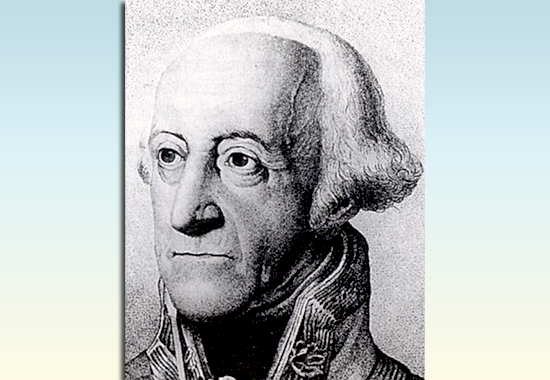
Frederick Josias of Saxe-Coburg-Saalfeld
1737-1815
For the Germans, Frederick was
Prinz (Prince)
Friedrich Josias, Herzog (Duke) von Sachsen-Coburg-Saalfeld.
|
|
In short and
in English, Prince of Coburg.
Or Frederick
Josias.
Image Above
Frederick Josias of Saxe-Coburg-Saalfeld 1737-1815
Engraving by
unknown artist
Wiki |
Frederick Josias was a general in the
Austrian army, and the most successful military commander
the House of Saxe-Coburg had produced. As such, he became
well-known for his determination, courage, and prudently
executed strategy.
The good people of Coburg best
remember him for his protection of their city against
Napoleon's army in 1806.
Frederick Josias'
Family
Frederick's father was the Duke
Francis (Franz) Josias of Saxe-Coburg-Saalfeld. His mother was Princess
Anne Sophie (Anna Sophia) of Schwarzburg-Rudolstadt.
Frederick Josias was their
third and youngest son, born on
December 26, 1737 at Ehrenburg
castle in Coburg. Here is a photograph:
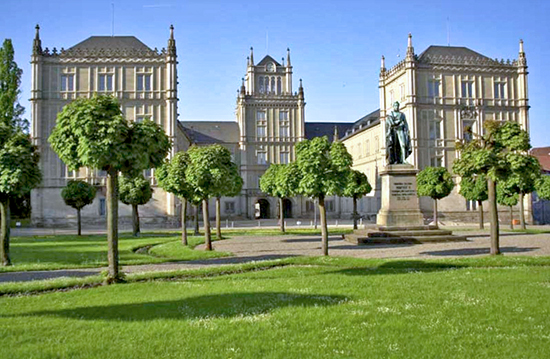
Ehrenburg
Castle, Coburg, Germany
Photo: Frankenradar
Upon completion of its construction in 1547,
 Emperor Charles V
decided to call this palace Ehrenburg (Honor
Castle) because the building was erected without forced
labor.
Emperor Charles V
decided to call this palace Ehrenburg (Honor
Castle) because the building was erected without forced
labor.
Back to Frederick Josias.
In 1755, he visited his sister
Charlotte Sophie and her
husband in Mecklenburg.
He then traveled to Vienna where
he lived with his sister Friederike
Caroline.
Frederick Josias'
Career
On January 4, 1756, 19-year-old
Frederick Josias entered the Imperial Austrian Cuirassier
Regiment Number 33 "Anspach" as cavalry captain. His unit
was stationed at Ödenburg (Austrian Empire, today's Sopron
in Hungary.)
Third Silesian
War (1756-1762)
The
 Third Silesian War
was part of the
Third Silesian War
was part of the
 Seven Years' War.
Austria and Prussia fought over Silesia.
Seven Years' War.
Austria and Prussia fought over Silesia.
Here is the map.
Frederick Josias' hometown Coburg is in square C-II.
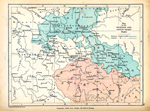
1740-1763 Map for
the Silesian Wars and the Seven Years' Wars
Click to enlarge.
On October 1, 1756, Frederick
Josias fought in the Battle of
Lobositz, which ended with a draw.
On May 6, 1757, he fought in the
Battle of Prag, which
ended with a Prussian victory.
On April 1, 1758, he was
promoted to lieutenant colonel.
On October 14, 1758, Frederick Josias
fought in the Battle of Hochkirch,
in Saxony. During battle he was wounded but fought until
the enemy was beaten. The Austrians defeated the Prussians.
On January 13, 1759, twenty-one
year-old Frederick Josias was promoted to colonel.
On June 23, 1760, he fought in
the Battle of Landeshut
(today's Kamienna Góra in Poland.) Austrian victory.
On August 15, 1760, he fought in
the Battle of Liegnitz,
in which the Austrians were defeated
After this war, in 1766, he was promoted to
major general.
He made Field Marshal-Lieutenant
in 1773.
From 1778 until 1786, he was
General Commander in Pressburg (today's Bratislava in
Slovakia.)
On August 22, 1786, he became
Commander General of Galicia and Bukovina.
Russo-Turkish
War (1787-1791)
The Austrians allied with
Russia. Thus, Frederick Josias found himself fighting in the
 Russo-Turkish War of 1787 alongside the Russians against the
Turks. In fact, he was commanding an army of 300,000, which
he led into Turkish Moldavia from the west in support of
Russia.
Russo-Turkish War of 1787 alongside the Russians against the
Turks. In fact, he was commanding an army of 300,000, which
he led into Turkish Moldavia from the west in support of
Russia.
In 1788, he arranged for the
Siege of Chocim, also
spelled Khotin or Chotin, today's Khotyn in the Ukraine. The
siege lasted three months, from July 2 until September 19,
1788, after which the city fell.
Frederick Josias then marched on
and took Jassy, which is today's Iasi in Romania, and was back in the days
the capital of Moldavia.
On July 30, 1789, he fought in
the Battle of Focsani (Focksan, Fokshany, today's Foçsani,
Romania.) In this battle, Frederick Josias joined forces
with the Russian general
 Aleksandr
Suvorov, and his army of 60,000. Russian
victory.
Aleksandr
Suvorov, and his army of 60,000. Russian
victory.
On September 22, 1789, he fought
in the Battle of Martinesti.
Huge Russian victory and a nice badge, the Military Order of
Maria Theresa, for Frederick Josias. Here is the good piece:
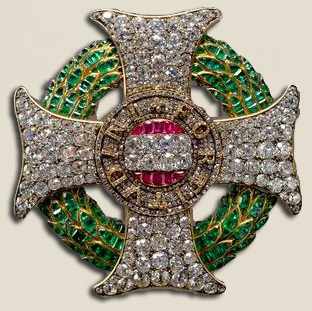
Military Order
of Maria Theresa
Großkreuz des Militär-Maria-Theresien-Ordens
© Kunsthistorisches Museum
Vienna
This one here, by the way, is
the very one Count Radetzky
had
received in 1854.
The Order of Maria Theresa is
not only a very
valuable brooch, but also comes with a nice pension for the
rest of your days.
And here is the map at the end of the Russo-Turkish war of
1787:
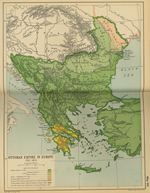
Ottoman Empire in Europe 1792
In 1791, Frederick Josias returned home to Coburg where he
was now a celebrity.
He visited Rodach and Neustadt
and, in 1794, decided to settle at Coburg. He acquired some
property on the Bürglaß and built
himself a humble retirement home. Today, this
building is known as the Bürglaßschlösschen, the Little
Palace on the Bürglaß.

Bürglaßschlösschen Coburg
Photo: Störfix / Wiki
However, the Austrians couldn't
do without him just yet.
After the outbreak of the
 French
Revolution in 1789, Europe was now at war.
French
Revolution in 1789, Europe was now at war.
French
Revolutionary Wars (1792-1802)
In 1793, Frederick Josias was
made commander-in-chief of the army of the Austrian
Netherlands, more than half of which were Austrians. Holy Roman emperor
 Francis II
needed some oomph
against the French. Francis II
needed some oomph
against the French.
On March 1, 1793, Frederick
Josias won the
 Battle of Aldenhoven
and on March 18, 1793, he won the
Battle of Aldenhoven
and on March 18, 1793, he won the
 Battle of Neerwinden.
A few days, later on March 21, 1793, he won the
Battle of Leuven, also
called Louvain. Thanks to these victories, Austria was able to reclaim the
Austrian Netherlands.
Battle of Neerwinden.
A few days, later on March 21, 1793, he won the
Battle of Leuven, also
called Louvain. Thanks to these victories, Austria was able to reclaim the
Austrian Netherlands.
But in the end, Austria had to
evacuate Belgium and the Netherlands. On June 26, 1794, the
French won the
 Battle of Fleurus. Frederick Josias opted
for a clean cut and quit his
job. His successor as commander-in-chief became
General Clerfayt.
Battle of Fleurus. Frederick Josias opted
for a clean cut and quit his
job. His successor as commander-in-chief became
General Clerfayt.
The Prince of Coburg returned to
his hometown on September 11, 1794.
The good people of Coburg were thrilled to have him back and greeted him in
front of the city's gates, after which they took their hero
on a triumphal procession through town.
War of the
Fourth Coalition (1806-1807)
The
 War of the Fourth Coalition
was part of the
War of the Fourth Coalition
was part of the
 Napoleonic Wars.
Napoleonic Wars.
In October 1806, Napoleon's
troops, led by French marshal
Augereau, marched against Prussia and, on their
way, made a pit stop at Coburg, then a Prussian ally.
All eyes on Frederick Josias,
who met with Augereau and who, by means of skilled diplomacy
and clever negotiations, managed to protect the city of Coburg from
a thorough ransack.
Frederick Josias died on
February 26, 1815 at Coburg.
On October 24, 1911, the city of
Coburg erected a monument in his honor.
Here it is:
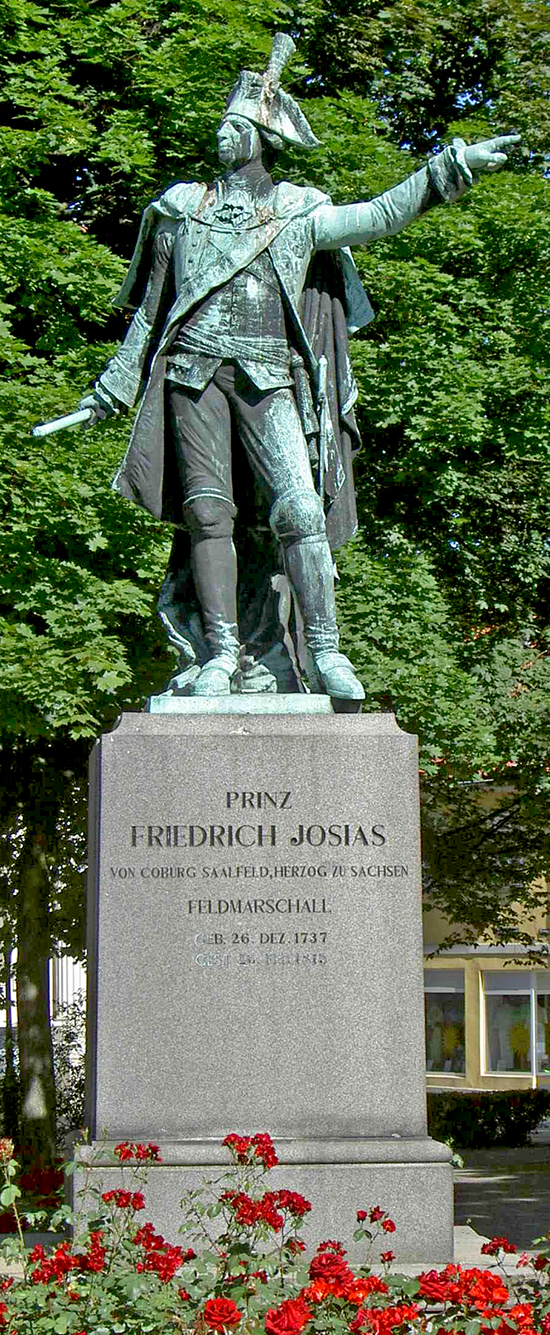
Friedrich
Josias' Monument at Coburg, Germany
Photo: Michael
Schlichting
More History
|